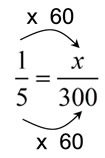|
The formula we have been using to find theoretical probability ratios:
can be used, along with some math skills,
to predict other outcomes associated with that probability and simple events.
Consider: You have a spinner divided into 5 sections of equal area (size). You know that the probability of the arrow landing on "7
"
is "1 out of 5", or 1/5, or 20%.
If you spin the arrow 300 times, predict how many times the arrow
will land on "7". |
|
Three Solution Approaches:
Use a proportion:
x = 60 times |
Use a percent:
20% of 300
0.20 x 300 = 60
60 times
|
Use observation:
We know: 1 out of 5 times.
We need : ___ out of 300 times.
Since 5 x 60 = 300,
then the prediction is 1 x 60 = 60,
60 times |
| Solution: It is predicted that the "7" should appear 60 times in the 300 spins of the arrow. |
Remember this "prediction" may not be the exact number you will see when the arrow is spun 300 times and the number of times a "7" appears is counted. The actual number of times a "7" appears may be slightly higher or slightly lower than the predicted number. The actual result should, however, be "close" to the predicted value, unless something unexpected has occurred to interfere with the results.

A referee tosses a coin to start the big game. If this referee officiates at 22 games during the season, predict how many times he will toss a head, assuming one toss per game?
The theoretical probability ratio of tossing a head will predict "1 out of 2"
or 1/2.
If the referee tosses a coin 22 times, he can expect 11 of them to be heads. |
|
|


A die is rolled 450 times and all rolls that show 3 or less on the die are recorded. Predict how many times a 3 or less should appear during 450 rolls of the die.
("3 or less" means a 1, 2 or 3 can appear out of the 1, 2, 3, 4, 5, 6 that could possibly appear on one die.) |
|
The theoretical probability ratio of rolling a 3 or less on a die is "3 out of 6" or 3/6 or 1/2.
If the die is tossed 450 times, a 3 or less should appear on the die 225 times. |

A spinner is divided into 8 numbered sections of equal size. The spinner is spun 200 times and the arrow lands on the number 3 a total of 25 times.
Is the number of times that a 3 appears, in the 200 spins, in keeping with what would be the "predicted" value of a 3 appearing?
The theoretical probability ratio of a spin landing on 3 will predict "1 out of 8" or 1/8.
The 200 spins resulted in "25 out of 200", or 25/200, landing on a 3.
|
|
 so, yes, the results from the 200 spins are in keeping with exactly what would be the predicted number of 3's appearing. so, yes, the results from the 200 spins are in keeping with exactly what would be the predicted number of 3's appearing.

NOTE: The re-posting of materials (in part or whole) from this site to the Internet
is copyright violation
and is not considered "fair use" for educators. Please read the "Terms of Use". |
|
|
 so, yes, the results from the 200 spins are in keeping with exactly what would be the predicted number of 3's appearing.
so, yes, the results from the 200 spins are in keeping with exactly what would be the predicted number of 3's appearing.